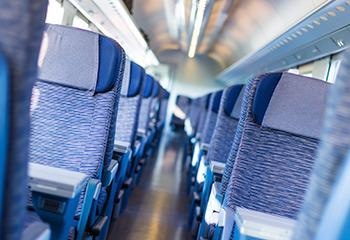Unsurprisingly, traveling by train is an ever-increasingly preferred method of travel. New commuter rail projects or expansions are scheduled for service in Atlanta, Washington D.C., Minneapolis, Baltimore, Boston, and Los Angeles.
Moreover, in 2019, the European Union witnessed a 3.4% increase in the number of passengers traveling by train year-on-year. Tourists are increasingly being offered scenic, luxury train routes as an alternative vacation option - where the train is both destination and transportation.
One of the factors driving a boom in rail travel is that today’s travelers are interested in minimizing their carbon footprint. Thanks to a reduced reliance on fossil fuels and consequently less pollution, rail transportation is better for the environment.
The latest “flygskam” (translation: flight shame) movement in Europe, which grew out of Sweden, encourages people to choose trains over planes whenever possible.
Simultaneously, high urbanization rates in regions such as Latin America and East Asia have motivated a responsive revitalization of urban rail infrastructure. Already, China hosts a high-speed rail network that is the longest and most extensively used in the world; the Asia/Pacific region is home to the bulk of the most recently laid track.

Figure 1. In much of the world, passenger rail is on the rise. Image Credit: Muratart/Shutterstock.com
Even the United States, which has a historical preference for traveling everywhere by car, offers reason for optimism, as unsustainable congestion in the skies and on the roads has given way to a search for alternative routes.
A common factor that is taken into account when selecting rail transit is usually the overall travel experience, including comfort and safety.
Addressing these factors directly is not only a challenge for manufacturers of railway cars but it also offers an opportunity: providing a better travel experience could boost the number of rail passengers, offering manufacturers and passengers a series of benefits alike.
One effective way to bolster safety, comfort and the experience of rail travel is to incorporate advanced tape solutions into the construction of railway cars and components. As a materials solution provider, Saint-Gobain is able to offer some recommendations.
Railway Material Safety and Standards
Safety is one of the main aspects that drives any industry. While rail travel is considered a generally safe mode of travel, accidents tend to get significant media attention when compared to the more commonplace car crash.
After all, trains carry a greater number of passengers. Therefore, ensuring railway cars are safer not only benefits the passengers but also promotes the industry’s credence as a feasible means of travel.
Like the aerospace industry, one major safety consideration for passenger rail is flame retardancy. Saint-Gobain® Norseal® Foam and Sponge Products are employed in various transportation applications to produce protective gasket seals against penetration from the elements, such as air and moisture; they are also used to guard against fire and smoke.
The flame retardancy ratings are a key factor to take into account when selecting the materials for rail-related construction, as they can be the difference between a minor event and a major tragedy.
Such ratings are predicated on testing against a range of standards, which vary from region to region. Examples include ASTM E162, which measures flame spread; ASTM E662, which measures smoke density; and ASTM C1166, which specifically looks at flame prorogation in elastomeric gaskets.
The Bombardier SMP 800-C test measures certain materials frequently used in vehicle construction and the toxic gases they release during combustion. EN 45545-2 is a European standard that also offers a fire resistance classification.
Igniting silicones with relatively forgiving ratings can produce a hazardous “flaming gasket” situation, with the capacity to spread fire to other compartments of the vehicle. By contrast, advanced tape solutions, such as the Norseal Silicone Product Line, offer low outgassing and high flame retardancy. This can be interpreted as a cleaner, low-toxicity white smoke when ignited and reduces the potential of flames spreading.
Another safety measure worth considering is the sealing of electronics, such as those found in access panels, lighting and other enclosures.
Relevant ratings are predicated on UL 94, a standard used to test plastic parts flammability in devices and appliances, and UL 50E, which specifically deals with electrical equipment enclosure - presenting yet another application for the Saint-Gobain Norseal Silicone Products.
Silicone Foams for Rail Comfort
Comfort is a more subjective quality and experience compared to safety; there are no published exact standards that can be used to deduce the comfort-pleasure levels that a passenger experiences while traveling on a vehicle.

Image Credit: Matej Kastelic/Shutterstock.com
However, a recent article published in the journal Transportation Research Interdisciplinary Perspectives (TRIP) offers some instructions for the rail industry, as it notes that “bus and train riders experience the most negative emotions in comparison with other transport modes such as private car, walking and cycling.”
The authors suggest that improving comfort and convenience could be a cost-effective way to boost ridership.
Foam solutions have the capacity to enhance comfort in a range of scenarios throughout a railway car cabin, where applications include HVAC seals, windows and intake gaskets.
As previously noted, foam and sponge tapes can be applied to form gasket seals that offer a protective barrier against a range of external elements, such as air, dust and light; ultraviolet rays and ozone gas; and different moisture conditions caused by weather such as rain, sleet, snow and frost.
With the capacity to endure wide temperature ranges, they can also be used as thermal insulation.
Additionally, tape solutions can be utilized for internal door seals and other applications to provide acoustic insulation, aiding the acoustic comfort of a cabin via noise damping or soundproofing. Seating and floor panels cushioned by tape can reduce vibration and optimize seat comfort.
Norseal Silicone Products
It is not an overstatement to say that Saint-Gobain offers a product for every possible application - if an unconventional application arises, company experts can engineer a customize a solution. The Norseal Product Line is well-matched to meet the safety, comfort and travel experience expectations of rail passengers.
F-12/F-20
Norseal F-12 and Norseal F-20 Silicone Foam Products deliver exceptional flame resistance, low toxicity and smoke generation, complying with the highest EN 45545-2 hazard classification (HL3).
Both types have the capacity to endure exposure to temperatures ranging from -51°C/-60°F to 204°C/440°F. They offer a superior compression set value, meaning that a low percentage of permanent deformation takes place under pressure (5% for F-12, <5% for F-20).
One main difference between the two types can be seen in cell structure and density properties. F-12 offers a low-density (192 kg/m3) modified cell structure, meaning it is lightweight and easy to process. When utilized as a fire-blocking foam for gaskets, seals and cushioning, it can be laminated to cover seat fabrics and carpeting, acting as a flame-resistant backing.
Its significant weight savings mean that it can also be used in aircraft and aerospace applications for additional fuel efficiency.
F-20 possesses a medium-density (320 kg/m3) closed cell structure and is utilized for flame-retardant performance in gasketing, insulation and dampening applications. It delivers exceptional resistance to environmental conditions, with a dual-sided smooth surface protecting against air, dust, light and moisture ingress.
Applications for both these types include door nosing, window gaskets, lighting seals, inter-car diaphragms and access panel seals. Saint-Gobain also offers a film-supported adhesive for application to each type to produce a pressure-sensitive adhesive form that aids in gasket placement. In this situation, the F-12 becomes SNS 512AF, and the F-20 becomes SNS 520AF.
R10400/R10460
Norseal R10400 and Norseal R10460 flame-retardant silicone sponge rubber products provide excellent flame resistance, low toxicity and smoke generation, compliant with EN 45545-2 classification HL2.
Both types have the ability to withstand extreme temperature ranges (-73°C/-99°F to 260°C/500°F) while delivering excellent mechanical properties; respective compression set values are 10% (R10400) and 5% (R10460).
These products are closed-cell in structure, with respective densities of 560 kg/m3 (R10400) and 470 kg/m3 (R10460). Providing exceptional weatherability and non-stick properties these products are both flexible and compressible. Applications for both tape types include HVAC seals, seat frame coverings, and thermal/acoustic insulation.
Silicone rubber chemistry is one main difference that sets these two products apart. R10400 uses high consistency silicone rubber (HCR) chemistry with flame-retardancy meeting UL 94-V0; this makes its mechanical strength properties superior to other silicone rubber systems - enhanced tear strength, tensile strength and abrasion resistance.
R10460 is a mid-grade silicone sponge with flame-retardancy compliant with UL 94 HBF that can be utilized in most gasketing applications.
FS1000 Series
The Norseal FS1000 Series is a fire-blocking polyurethane foam tape developed to be airtight, watertight and thermally insulating.
It provides the novel property of intumescence: when subjected to heat temperatures greater than 200°C/392°F, it expands to a fire-resistant char, sealing gaps and impeding the spread of fire, smoke and hot gases.
Compliant with EN 45545-2 classification HL2, it is able to endure a modest temperature range (-40°C/-40°F to 100°C/212°F). Compression set value is 5%; density is 240 kg/m3.
Soft and extremely malleable to uneven surfaces, the tape can be compressed with little effort to create air and water seals. Its resilience also offers vibration damping properties.
It finds application across a range of industries, including aerospace (seats, freight compartments), automotive (fuel tanks, battery packs) and construction (building joints, HVAC) due to its protective abilities.
Common Norseal Silicone Features
All Norseal Silicone Products can be used for both internal and external seals, with compression set values that deliver shape recovery after extended compression; this means long-life seals are produced that, in turn, reduce maintenance costs.
These are specifically relevant to the rail industry, as sealing sensitive components and absorbing vibration from travel on the rails and from the frequent cycling of railway car doors is crucial.
While the sophisticated, high-performance nature of the Norseal Silicone Products offer a premium solution, it also prolongs the lifespan by 10-plus years, meaning manufacturers are able to realize cost savings by the end-of-product lifecycle.
Readily available form factors include dry-back gasketing, or pressure-sensitive/strip-n-stick (SNS) tapes for instant gasketing. Sealing abilities can also be adjusted by modifying surface qualities.
Tested and Verified Rail Solutions Partner
In terms of meeting current opportunities and overcoming challenges, there are a number of routes railway manufacturers can take.
The tape solutions outlined here are both advanced while offering good value that becomes apparent over time; while reducing initial expenditures is an option, compromising on material quality is not, as this compromises both comfort and safety.
Saint-Gobain is committed to building a long-lasting landscape for the promising future of passenger rail.
Contact Saint-Gobain to learn how you can benefit from its solutions for railway applications.

This information has been sourced, reviewed and adapted from materials provided by Saint-Gobain Tape Solutions.
For more information on this source, please visit Saint-Gobain Tape Solutions.